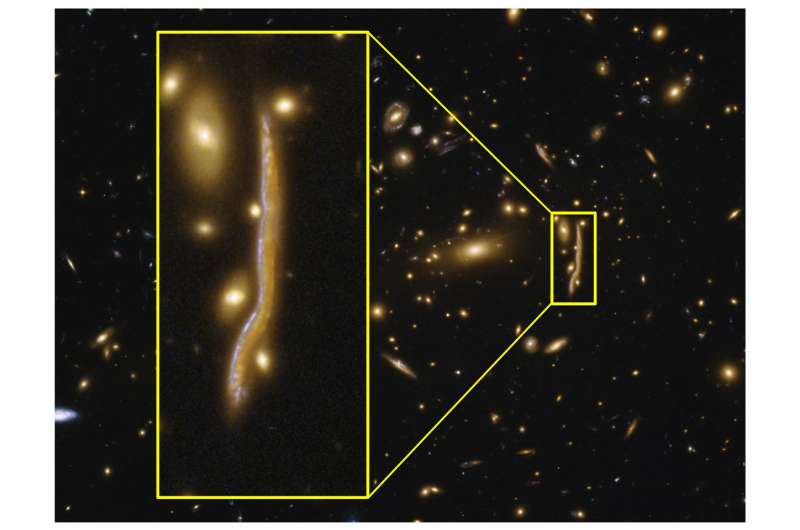The anatomy of a 'cosmic snake' reveals the structure of distant galaxies

We have a fair understanding of the fundamental mechanisms that regulate star formation in galaxies, from the interstellar matter to the diffuse clouds distributed in space whose gravitational contraction leads to the birth of stars within large stellar clusters. But observations of distant galaxies have questioned this picture, the size and mass of these distant stellar nurseries largely exceeding that of their local counterparts. An international team of astrophysicists led by the Universities of Geneva (UNIGE), Switzerland, for the observations and Zurich (UZH) for the simulations has tackled this inconsistency, which seems to question our knowledge of star formation when we study the early universe, far away in time and space. They have found the first answers thanks to new observations of the so-called cosmic snake. Their study is published in the journal Nature Astronomy.
The study of star formation relies on the coordinated work of several international teams that perform observations on different scales. The Hubble Space Telescope, when pointed toward high-redshift galaxies, studies in detail very distant objects when the universe was much younger, far away in time and space.
These observations have triggered an unexpected debate amongst astronomers: In the distant past, was star formation governed by different laws or physical conditions? This is what data from the Hubble Space Telescope apparently suggests with observations of distant galaxies revealing the presence of giant star-forming regions, clumps of gas and stars attaining sizes as large as 3000 light-years, a thousand times larger than those observed in the nearby universe. And these giant clumps, intriguingly, appeared to be ubiquitous in high-redshift galaxies.
The need for a gravitational telescope
The distance that separates us from these objects prevents their detailed observation, but the astronomers have overcome this difficulty exploiting gravitational lensing. The telescope is pointed in the direction of an extremely massive object whose gravitational field bends the path of the light coming from a more distant galaxy located behind it. The massive object's gravity thus creates multiple and amplified images of the distant galaxy, exactly like an optical lens.
In this case, the astronomers pointed Hubble at a huge gravitational lens that produces several stretched, warped and nearly overlapping images of a distant galaxy featuring a true star-forming "cosmic snake" region. "The amplified image is more precise, luminous, and allows us to observe details up to 100 times smaller," says Antonio Cava, lead author of the study.
The fact that the image of the source galaxy is repeated five times at different spatial resolutions allowed the researchers to perform a direct observation and to establish the intrinsic structure and size of the observed giant clumps. The researchers concluded that the giant clumps are in reality not as large and massive as suggested by previous Hubble observations. Instead, they are intrinsically smaller or composed of multiple unresolved small components. Valentina Tamburello from the Institute of Computational Science at UZH, a co-author of the study, says, "Thanks to the incredibly high resolution of the 'cosmic snake,' we were able to compare our calculations with the UNIGE observations and confirm their match. This was an incredible luck for us."
This is an important step toward understanding the fundamental mechanisms driving star formation in distant galaxies, even if it does not completely explain some of the observed differences with respect to local galaxies. "We have reduced the differences between what we observe in the nearby universe and in distant galaxies from a factor 1000 to a factor 10," says Daniel Schaerer, professor at the Geneva Observatory. He also points out the compelling convergence of ground-breaking observations and sophisticated state-of-the-art simulations, such as those developed by the UZH collaborators, which suggest that the remaining differences, can be explained by the turbulent nature of the distant galaxies.
More information: The nature of giant clumps in distant galaxies probed by the anatomy of the cosmic snake, Nature Astronomy (2017). nature.com/articles/doi:10.1038/s41550-017-0295-x
Journal information: Nature Astronomy
Provided by University of Geneva




















